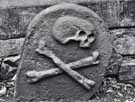
The medieval era Black Death killed an enormous number of people: One-third to one half of all Europeans. Yet, a recent article argues the plague benefited us. How? The survivors may have passed on genes that benefit us to this day.
Researchers studied the skeletal remains of plague victims which wasn't difficult since there were designated plague cemeteries. Those skeletons were compared with skeletons from other cemeteries of the same era. They found first that older people died at higher rates from the plague which is natural selection's way of removing the weakest part of the population. The surprising find was when they looked beyond the plague's dominant years and saw people were living longer. In medieval times, fifty was considered old age!
So children of parents or grandparents who survived the plague had a better chance of living to an older age. They inherited genes that gave their ancestors an advantage in surviving the plague. The impact of the selection imposed by the Black Death led to 200 years of increased lifespan in the general population.
Another advantage they passed on was the selection for a gene variant in Europeans called the CCR5-Δ32 allele. It's associated with people who show a higher resistance to HIV/AIDS. So, pandemics can have a profound effect on the evolution of human populations.
Take the latest Ebola crises. Seventy percent die while thirty percent survive. What genomic attributes do the survivors possess that give them an advantage scientists could use to develop a therapeutic? Ebola, just like the medieval plague, may be causing an evolution in human genome in modern times.
More Information
The Bright Side of the Black Death
by Pat Shipman, American Scientist, Vol 102, November-December, 2014, pages 410- 413.